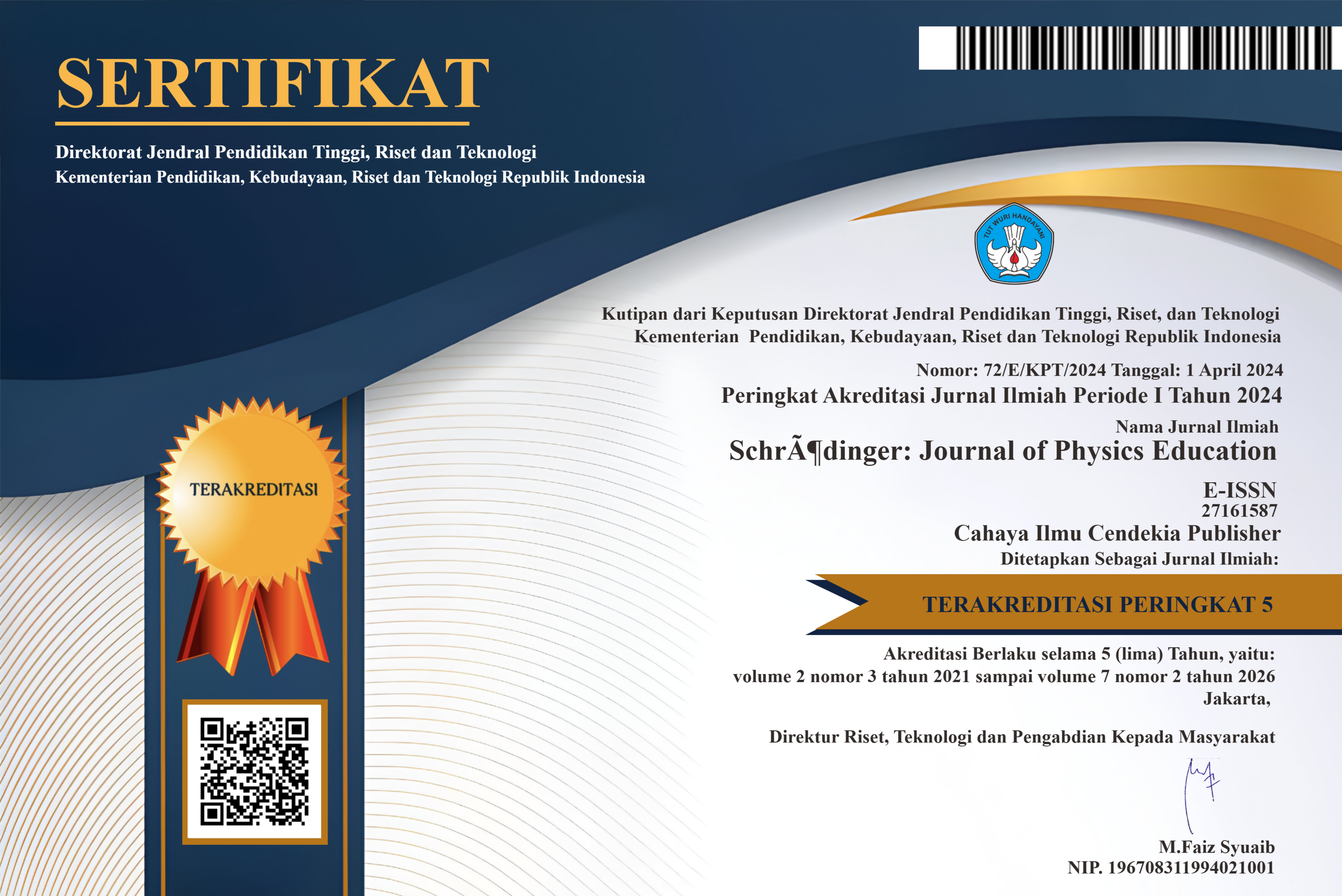Analisis Lingkungan Belajar Siswa Mata Pelajaran Fisika di Sekolah Menengah Atas Negeri 10 Kota Jambi
Abstract
Tujuan penelitian: Penelitian ini bertujuan untuk mengetahui lingkungan belajar siswa terhadap fisika di SMAN 10 kota Jambi
Metodologi: Jenis penelitian ini adalah instrumen kuantitatif yang digunakan adalah kuesioner. Subjek penelitian ini adalah 97 siswa di SMAN 10 kota Jambi. Teknik analisis data kuantitatif menggunakan statistik deskriptif
Temuan Utama: Hasil dari empat indikator yang dibahas dalam penelitian ini, indikator pada metode pengajaran fisika sebanyak 64,9% kategori baik. Untuk indikator hubungan guru fisika dengan 43,2% siswa dikategorikan baik. Kemudian pada indikator standar pembelajaran fisika sekolah terhadap 35% kategori baik. Sedangkan pada indikator tugas rumah terhadap fisika sebanyak 42,2% siswa dikategorikan cukup.
References
[2] Permatasari, DR, Soegiyanto, H., and Usodo, B. The use of discovery learning approach models with rme viewed from interpersonal intelligence. Journal of Education and Learning (EduLearn), 13 (1), 87, 2018
[3] Darmaji, D., Kurniawan, DA and Suryani, A. Effectiveness of Basic Physics II Practicum Guidelines Based On Science Process Skills. JIPF (Journal of Physical Education), 4 (1), 1-7, 2019
[4] Astalini, A. Kurniawan, DA & Sumaryanti, S. Student Attitudes Toward Physics Lesson in SMAN Batang regency. JIPF (Journal of Physical Education), 3 (2). 59-64, 2019
[5] Darmaji, D., Kurniawan, DA, Suryani, A. and Lester, A. An Identification of Physics Pre-Service Teachers' Science Process Skills Through Science Process Skills-Based Practicum Guidebook. Scientific Journal of Physical Education Al-Biruni, 7 (2), 239-245, 2018
[6] Azevedo, R. Computer environments as metacognitive tools for enhancing learning. Educational Psychologist, 40 (4), 193-197, 2005
[7] Schwonke, R Metacognitive Useful load, or extraneous concept? Metacognitive and self-regulatory demands in computer-based learning. Journal of Educational Technology & Society, 18 (4), 172-184, 2005
[8] Pelech, S.. Teaching science as a hermeneutic event. Journal of Applied Hermeneutic. 1 (1), 1-8, 2015
[9] Afifah, RN. Development of Student Worksheet (LKS) Based Natural Sciences Experimental Methods. PGRI University of Yogyakarta. 2015
[10] Chodijah, S., Fauzi, A., and Ratnawulan, R. Development of Physics Education Devices Using Condition Assessment Model Inquiryyang Guided Portfolio at Circular Motion material. Physics Education Research Journal, 1 (1), 2012
[11] Caliskan, H An Investigation into the Organization Levels of Social Studies Teachers with regard to Constructivist Learning Environments in Terms of Several Variables. Journal of Social Studies Education Research, 6 (1), 49-83.
[12] Baidi, B. The Role of Parents' Interests and Attitudes in Motivating Them to Homeschool Their Children. Journal of Social Studies Education Research, 10 (1), 156-177, 2019
[13] Suleman, Q. and Hussain, I.Effects of physical classroom environment on the academic achievement scores of secondary school students in Kohat division, Pakistan. International Journal of Learning & Development, 4 (1), 71-82, 2014
[14] Sugiyono . Educational Research Methods. Bandung. Alfabeta. 2018
[15] Kerlinger, FN .Foundations of behavioral research. Yogyakarta: Gadjah Mada University Press. 2014
[16] Saputra, R. Textbook Biostatitik In Public Health Sciences. Batam: College of Health Sciences Avicenna. 2016
[17] Cohen, L., Manion, L., & Marrison, K., Research Methods in Education, New York. Routledge. 2007
[18] Awaluddin, Murtiadi. Strengthening the Role of Work Environment and Culture Organizations in the Optimizing Performance Alauddin State Islamic University lecturer Makassar through job satisfaction. Journal of Management, Idea, Inspiration (MINDS), 5 (1), 53-67, 2018
[19] Febriany, R., & Yusri, Y. Attention parents relationship with Student Motivation Working Duties In School. Counselors, 2 (1). 8-16, 2013
Copyright (c) 2020 Cahaya Ilmu Cendekia Publisher

This work is licensed under a Creative Commons Attribution-NonCommercial 4.0 International License.
Authors who publish with this journal agree to the following terms:
- Authors retain copyright and acknowledge that the Schrödinger: Journal of Physics Education is the first publisher licensed under a Creative Commons Attribution 4.0 International License.
- Authors are able to enter into separate, additional contractual arrangements for the non-exclusive distribution of the journal's published version of the work (e.g., post it to an institutional repository or publish it in a book), with an acknowledgment of its initial publication in this journal.
- Authors are permitted and encouraged to post their work online (e.g., in institutional repositories or on their website) prior to and during the submission process, as it can lead to productive exchanges and earlier and greater citation of published work.






.png)
.png)








.png)
.png)
.png)







